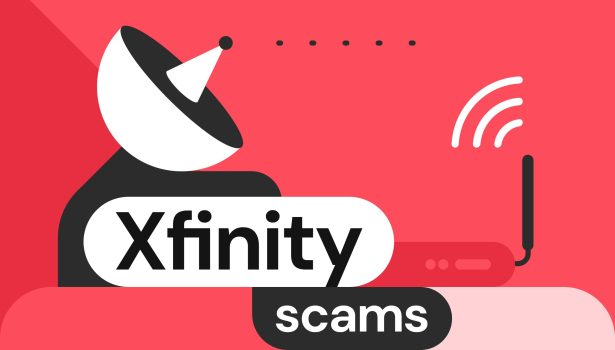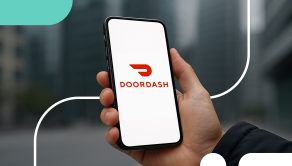Xfinity scams: how to recognize and avoid them

Comcast is one of the largest telecom providers in the U.S., marketing a family of cable, internet, phone, and wireless products under the Xfinity brand.
However, Xfinity scams have been on the rise since the two Comcast data breaches in 2023 and 2024, which affected Xfinity’s multi-million user base by exposing emails, phone numbers, and partial Social Security numbers.
Now that scammers have lavish Xfinity customer records on hand, it gets easier for them to target real Xfinity users with realistic phishing messages and spoofed phone calls impersonating Xfinity support.
Read this guide to the most common Xfinity (Comcast) scams, including phishing emails, text scams, and scam call scenarios you should learn to recognize and stop early.
Why Xfinity users are common targets for scams
Xfinity’s vast customer base—with close to 30 million residential broadband customers as of the end of 2024—and its wide range of services make it highly attractive to scammers.
Cybercriminals rely on Xfinity’s brand recognition and customer trust to trick people into falling for impersonators’ exploits and sharing sensitive information or money. Because Xfinity’s customers often receive bills and notifications via phone, email, and text messages, scammers can successfully exploit these contact points.
At the same time, Xfinity impersonation scam calls and phishing attacks are just part of a larger trend in telecom scams. For example, call spoofing and robocalls remain a growing global threat—research shows that subscriber’ losses to fraudulent robocalls can exceed $76 billion in 2025. Xfinity, being a household name, naturally attracts a disproportionate share of these attempts. From fake support calls to phishing texts, attackers use various tactics, making it easy to fall victim without proper vigilance.
Common types of Xfinity scams
Here are the most frequent scams targeting both Xfinity customers and people who are not even subscribers. Just like with Best Buy’s Geek Squad impersonation, scammers often target random contact lists obtained on the dark web or through data brokers, hoping they reach actual customers. It’s recommended that you stay aware and learn to recognize these scams as early as possible.
Xfinity support scam calls
Fraudsters engage in what is known as call spoofing—imitating a legitimate business’s caller ID and brand name to lower their target’s guard. They falsify the information to disguise their identity, and Xfinity is just one of the brands exploited by scammers this way.
Xfinity support impersonators typically warn that your account has been compromised, is expiring, or will be disabled unless you act immediately. When scammers can’t get through, they often leave voicemails urging targets to call back, otherwise they will lose access to their account or some perk or discount (not always real) they’re currently using.
Comcast Xfinity scam calls often follow these common scenarios, using high-pressure tactics to create panic:
- Claiming your discount on your monthly bill is about to be removed from your account, like in this common example of the Comcast Xfinity 50% discount call:
- Saying your service is scheduled for immediate disconnection due to unpaid bills or suspicious activity.
- Warning that your Xfinity-connected device has been hacked or infected with malware, and requesting remote access such as in AnyDesk scams.
- Offering an exclusive promotion or deal but demanding a small “activation fee” or your account credentials to claim it.
Phishing emails impersonating Xfinity
Comcast scams often start with phishing emails designed to imitate official company communication—complete with the logos, fonts, and branded colors—but containing malicious links that prompt you to enter sensitive data such as your Xfinity credentials or payment card information. Once entered, scammers exploit these details to steal money or take over your account.
Examples of Xfinity email scams include:
- Announcing updates to the terms of service or privacy policy and requesting you confirm by a strict deadline.
- Alerting you to a new voicemail you can access by following the link in the email.
- Requests to update or reactivate your Xfinity account, with warnings that access will be lost if you fail to act within a few hours or days.
- Sending “documents” related to your Xfinity account that require clicking a link to view.
- Requests to verify your email address to keep your Xfinity account active.
Fake Xfinity text messages
Similar to Xfinity phishing emails, fake text messages from Xfinity impersonators warn recipients about suspicious account activity, billing reminders, failed payment attempts, or identity verification requests.
Xfinity text scams always contain a link to a spoofed website, often disguised with a link shortener so you can’t see the destination. If you follow the link, you may be asked to enter information such as Xfinity credentials, full name, Social Security number, home address, and credit card details. These will be stolen by scammers once submitted. Additionally, your device may become infected with keylogger malware to capture credentials.
Xfinity billing scams and unauthorized charges
You might receive a phone call, email, or text claiming there’s a pending charge on your Xfinity account. Sometimes the scammer says you’ve subscribed to a premium service or on-demand content that you “forgot to cancel” after a trial period, and that your account will be suspended unless you pay.
To clear the balance, they might demand payment through unconventional methods such as gift cards, Amazon or Google Pay, or payment apps like Zelle or Cash App for instant transfers. In some cases, they may redirect you to a fake Xfinity payment portal to steal your credit card details.
How to spot Xfinity scams: red flags to watch out for
Remember that legitimate Xfinity representatives never ask for usernames, passwords, Social Security numbers, or credit card data. They also never request payments via gift cards, instant money transfer services, or cryptocurrency.
On the contrary, Comcast Xfinity scammers are relatively easy to spot if you know these common red flags:
- Xfinity emails sent from generic email services such as gmail.com and aol.com, or from domains designed to resemble xfinity.com and comcast.com but containing extra characters or altered names (for example, comcast.info).
- Unsolicited payment requests via unusual payment methods such as gift cards.
- Offers to upgrade your Xfinity plan in exchange for an upfront payment.
- Requests for personal information such as billing details, payment card data, or your Xfinity account password.
- Claims about problems with your account or payment method that you can’t confirm through official Xfinity channels.
- Links leading to websites with altered or misspelled versions of xfinity.com or comcast.com. In some cases, scammers disguise spoofed websites under seemingly legitimate URLs that still redirect to malicious websites.
- Urgency and scare tactics, often using subject lines like “Final Update!” or “Final Notice!”
- Phrases such as “read now” and “act now,” or the word “kindly,” as in “Kindly update your account information.”
- Odd greetings using your email address instead of your name, or phrases like “Dear Valid user.”
- Pressing deadlines that expire within a few hours or days.
How to protect yourself from Xfinity scams
Falling for Xfinity fraud and scams can hurt your wallet and self-esteem, with no guarantee of restoring your stolen funds if it happens. But you can take the following precautions to protect yourself and your loved ones from bad actors’ exploits:
- Enable two-factor authentication on your Xfinity account so that even if scammers obtain your credentials, they’ll still have difficulty accessing it.
- Never share your Xfinity verification codes with anyone.
- Never share your sensitive personal or payment information over unsolicited calls and messages.
- Don’t click links or download attachments in suspicious emails or text messages.
- If you’re worried about losing account access due to inactivity, simply log in again using any official Xfinity channel.
- Always verify suspicious charges by logging into your Xfinity account directly, without using links sent in suspicious messages.
- Go to xfinity.com or use Xfinity Assistant to verify caller IDs, emails, or texts allegedly from Xfinity. If you wonder what number Comcast calls from, dial 1-800-Xfinity (1-800-934-6489) to check if the communication is legitimate.
- Go through Xfinity users’ real scam reports to educate yourself on common types and variations of Xfinity phishing scams and Comcast security alerts.
- Download the Xfinity app only from the official website and never through third-party links shared by unknown or unverified contacts.
- Remove your personal contact information from the internet via services like Onerep to make it harder for scammers to target you.
What to do if you fell victim to an Xfinity scam
If you responded to an Xfinity scammer or interacted with a suspicious email or text message, take the following steps to protect your account, payment information, and identity:
- Report spam texts and emails using your provider’s built-in functionality. You can also forward spam texts to 7726.
- Report the scam to Xfinity by following these guidelines.
- If you received a phishing email, copy and paste it into a new email and send it to Xfinity’s abuse team at abuse@comcast.net.
- If you shared financial information with scammers or made transactions, immediately contact your bank or payment card issuer to set up fraud alerts and reverse the charges.
- File a complaint with the Federal Trade Commission.
- Take steps to protect yourself from identity theft.
- Share your experience with other Xfinity users on the official community forum to help others avoid falling for the same scam.
FAQs
Is there an Xfinity scam going around?
Yes, there are several Xfinity scams targeting customers, including Xfinity support impersonation, phishing emails and text messages, and fake charges.
How do I know if an Xfinity email is real?
Most importantly, check that the sender’s domain is the official (xfinity.com). If you suspect it’s phishing or spam, verify the information by logging into your Xfinity account directly or by calling 1-800-Xfinity (1-800-934-6489).
Will Xfinity refund scam-related charges?
Xfinity may refund scam-related charges in certain situations, but it’s not guaranteed. To discuss your particular case, report the scam to official Xfinity support and provide evidence. If you sent funds to scammers using your bank card, contact your bank directly to notify them of a fraudulent transaction.
What number do I call to report Xfinity scams?
You can report scams through Xfinity’s official online support channel and by forwarding phishing emails to abuse@comcast.net.
Can scammers spoof official Xfinity numbers?
Yes, scammers can fake Xfinity caller IDs to make calls appear legitimate. This is a common call spoofing technique used by scammers, so in case of doubt, hang up and call the official Xfinity support line directly.





Dimitri is a tech entrepreneur and founder of Onerep, the first fully automated data removal service. Top cybersecurity CEO of 2021 by The Software Report.